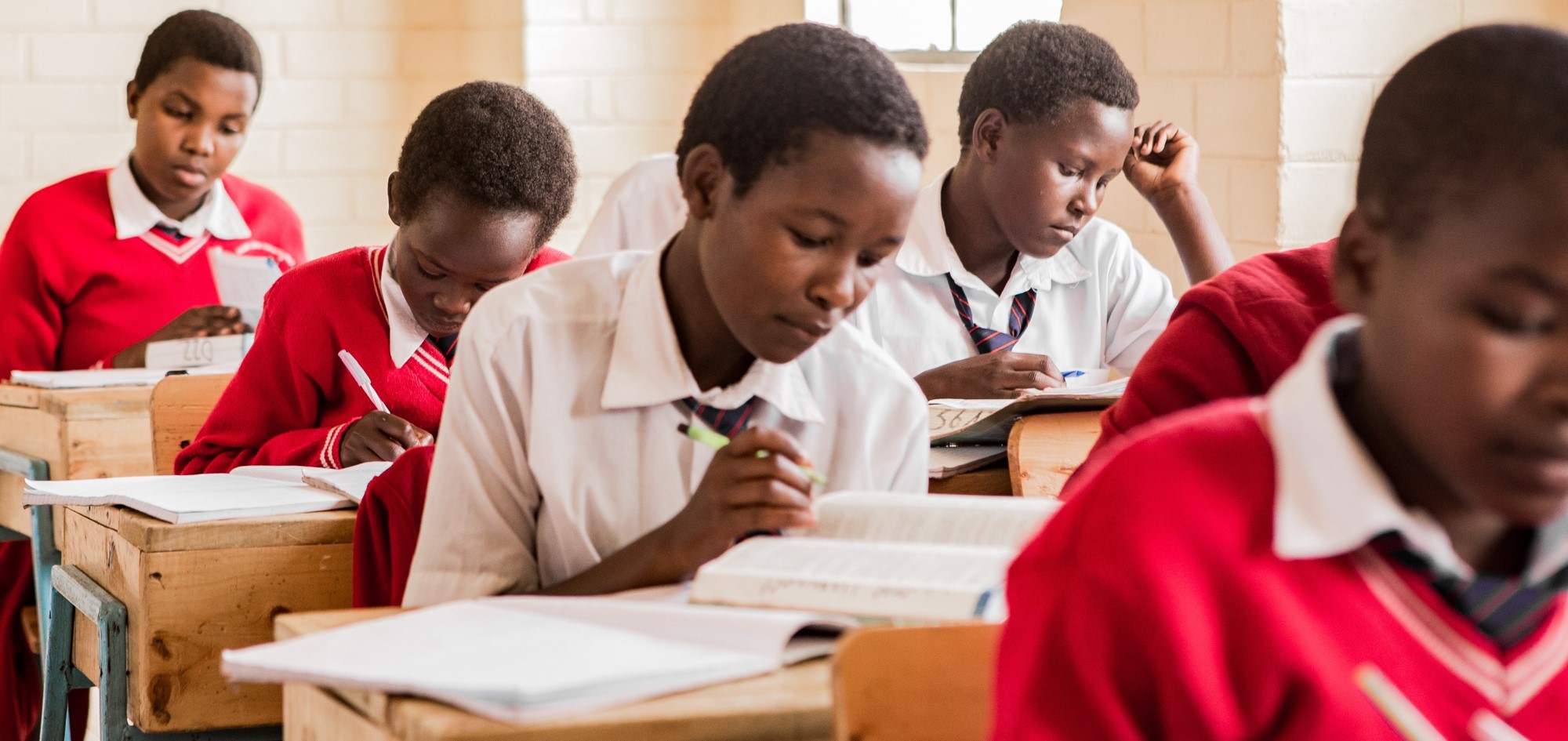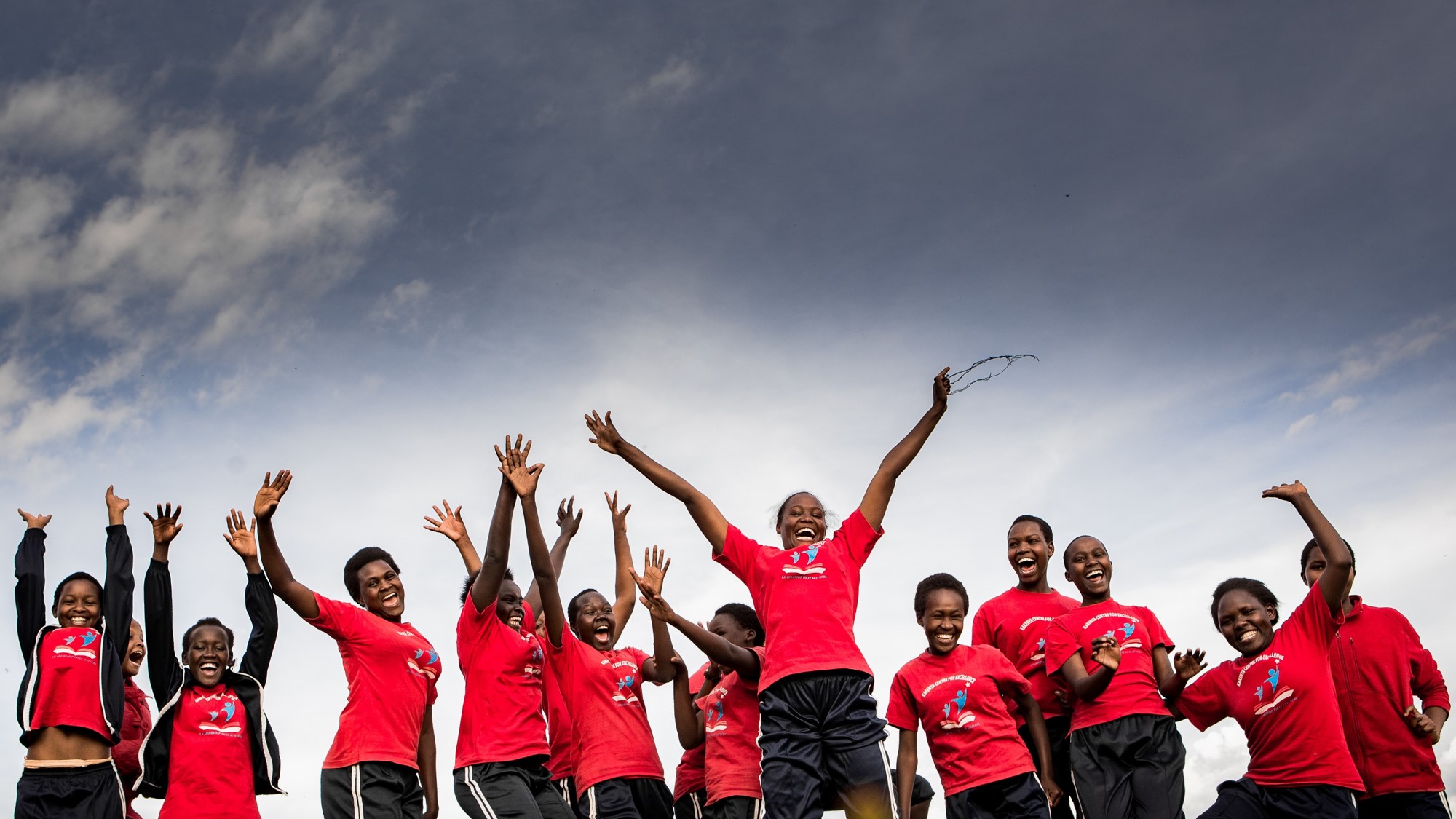
About the Together Women Rise Grants Program
The Together Women Rise Grants Program has two key components that support our overall mission to achieve global gender equality. Featured Grants are largely focused on delivering direct services by funding grassroots organizations that empower and support women and girls in low-income and marginalized communities in the Global South. Our Transformation Partnerships are designed to invest in areas where we can make the biggest impact on achieving global gender equality by addressing the root causes of gender inequality.
Through our Featured Grants Program, we highlight a different organization/project each month, providing a variety of learning materials on the issue and how the grant will be used. Through the Featured Grants program, we support capacity building, new programs, or expansion of existing programs. The following is information on the grant we are featuring for February 2025.
The Global Issue
Using Education as an Andidote to End FGM/C
| “From the day I was cut, I carried pain, stigma, and emotional, psychological trauma. The pain is always there.”
– Catherine Meng’anyi, Kenyan FGM/C survivor, nurse and advocate |
Over 230 million girls and women worldwide have undergone female genital mutilation/cutting (FGM/C), with Africa accounting for the largest share of this total: 144 million. Asia follows with 80 million, with an additional 6 million in the Middle East. The practice is also found in pockets of Europe and in Australia and North America. The most frequently cited reasons for carrying out FGM/C are social acceptance, misconceptions about hygiene, a means of preserving a girl’s virginity, making the woman “marriageable,” and enhancing male sexual pleasure. The World Health Organization states unequivocally that FGM/C has no health benefits.
When a girl undergoes FGM/C, her childhood is essentially over. She typically drops out of school and is promptly married off at a young age to secure a “bride price” (a payment made by the groom to the family of the bride). Without education, she is then unable to secure livelihood, positioning herself and her family for a life of poverty, thereby perpetuating the cycle. FGM/C is condemned by international treaties and conventions, as well as by law in many countries – yet it continues.
The phrase “Information is Power” has no better place than in the fight against FGM/C. Opposition to FGM/C is highest among girls and women with more education. Girls and women with a primary education are 30% more likely than those with no education to oppose FGM/C. This rises to 70% among girls and women with a secondary education or higher. There are several factors that may affect this dynamic. One is that while in school, girls develop ties with peers and mentors who oppose FGM/C. Educational settings may also provide opportunities for discussion conducive to the formulation of new ideas. Educated girls and women have greater exposure to intervention programs, media messages, and local and international discourse that denounce the practice. It is clear that educating women and girls can decrease FGM/C. The challenge is to keep women and girls in school. Across the globe, 130 million girls ages 6-17 years are currently not in school.
While FGM/C continues, evidence shows it is declining in areas where it was once universal. However, progress is not happening everywhere, and change of this magnitude is slow. Education is critical in the fight to combat FGM/C and end it for good.
| In the United States, approximately 513,000 women and girls have undergone or are at risk of FGM/C. Women and girls who were born in the US may be subjected to it here or even during vacations to the countries of origin – a practice known as “vacation cutting.” |
About Our Grantee
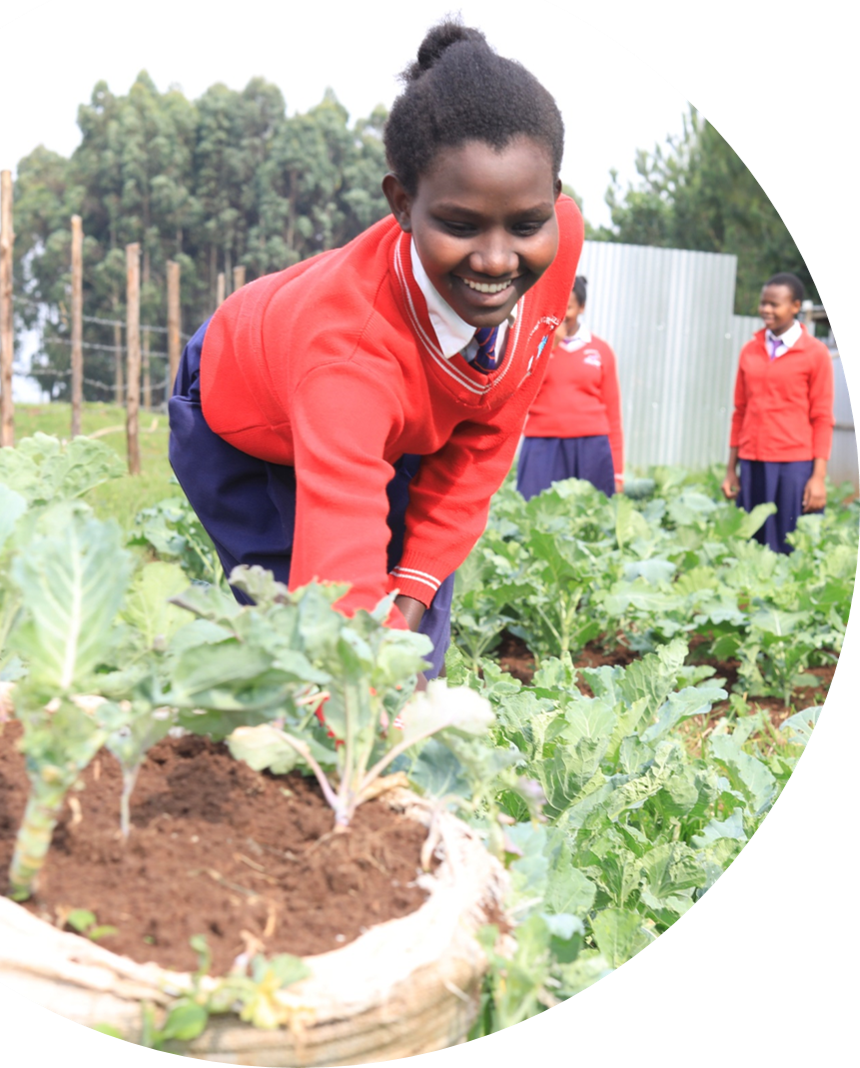 Together Women Rise is funding a $50,000 Featured Grant to Kakenya’s Dream, supporting the Kakenya Center for Excellence II (KCE II).
Together Women Rise is funding a $50,000 Featured Grant to Kakenya’s Dream, supporting the Kakenya Center for Excellence II (KCE II).
Kakenya’s Dream
Kakenya’s Dream started as a simple dream in 2008: a world where African women and girls are valued and respected as leaders and equals in every way. Its mission is to invest in girls from rural communities through education, health, and leadership initiatives to create agents of change, and its main purpose is to combat extreme gender inequality perpetuated by patriarchal societal norms and harmful traditional practices like FGM/C and child marriage that deprive girls of opportunity. Wraparound programs nurture and support the whole girl, from childhood to adulthood.
Kakenya’s Dream was founded by Dr. Kakenya Ntaiya. Engaged at age five, Dr. Kakenya Ntaiya experienced female genital mutilation (FGM) as a young teenager in preparation for marriage. Her life was set to follow the traditional Maasai path of ending school to become a wife and mother, but Ntaiya had a different dream. She negotiated with her father to return to school after surviving FGM. When she was accepted to college in the United States, she promised to use her education to help the village in exchange for their support. She went on to earn her PhD in education at the University of Pittsburgh, and returned to her community to fulfill her promise. You can hear more of Kakenya’s inspiring story by watching her TED talks here or by attending Together Women Rise’s webinar at 8 p.m. EST/5 p.m. PST on Feb. 6. Register here.
The organization now includes two boarding schools, supports girls across Kenya with scholarships, teaches sexual and reproductive health (SRH) education in partner schools, leads extensive community outreach activities, and is preparing to open a youth-friendly health clinic. As a result of this work, 968 girls have received life-changing education and support through Kakenya’s Dream boarding schools. These schools have maintained a 100% transition rate from primary to secondary education – compared to the county’s average rate of 58% – and all students have remained free from FGM/C and child marriage. In addition, nearly 33,000 boys and girls have been educated on their health and human rights across partner schools, and more than 7,000 community members have been directly reached with critical messaging on the prevention of teen pregnancy and the dangers of harmful traditional practices.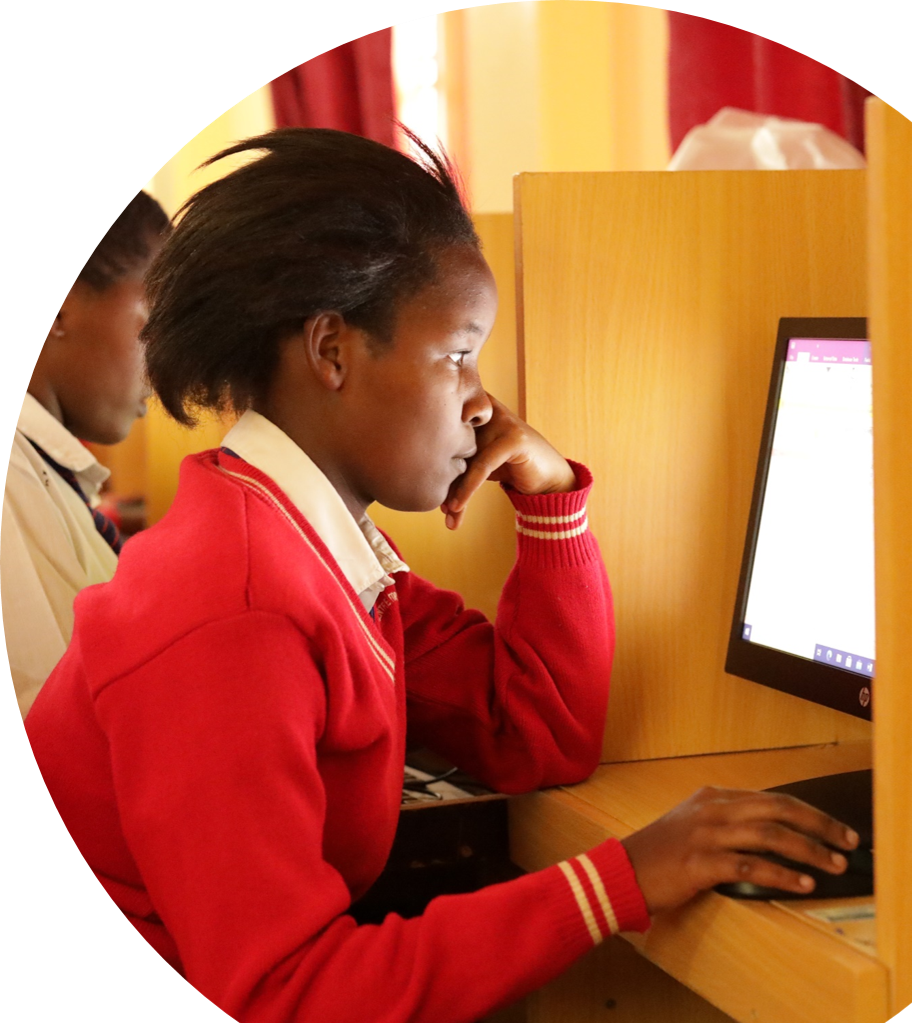
Kakenya’s Dream has received two prior featured grants from Together Women Rise. A 2014 grant supported expansion of the Kakenya Center for Excellence Health and Leadership program to schools around the region. An additional grant in 2019 funded training of more youth in sexual and reproductive health and leadership skills, as well as continued expansion of the Health and Leadership Training program through a new peer-to-peer component. This ongoing partnership has increased enthusiasm and support in the community, leading to even more interest in programs than expected.
Since it began, the staff of Kakenya’s Dream has witnessed dramatic shifts in attitude and behavior in their communities. In the beginning, buy-in of community leaders and fathers came with obstacles. Today, Kakenya’s Dream is regarded as an important leader in a community that values educating a girl. Elders and religious leaders are embracing the teaching of sexual and reproductive health information (normally considered taboo), and fathers are accompanying their daughters on school visits and demonstrating pride for their daughters’ academic potential, which used to be rare. To quantify these attitudinal and behavioral changes, Kakenya’s Dream is partnering with the Gates Foundation to conduct a community wide census in 2025. This census will be repeated in five years.
LEARN MORE ABOUT KAKENYA’S DREAM.
Life Challenges of the Women & Girls Served
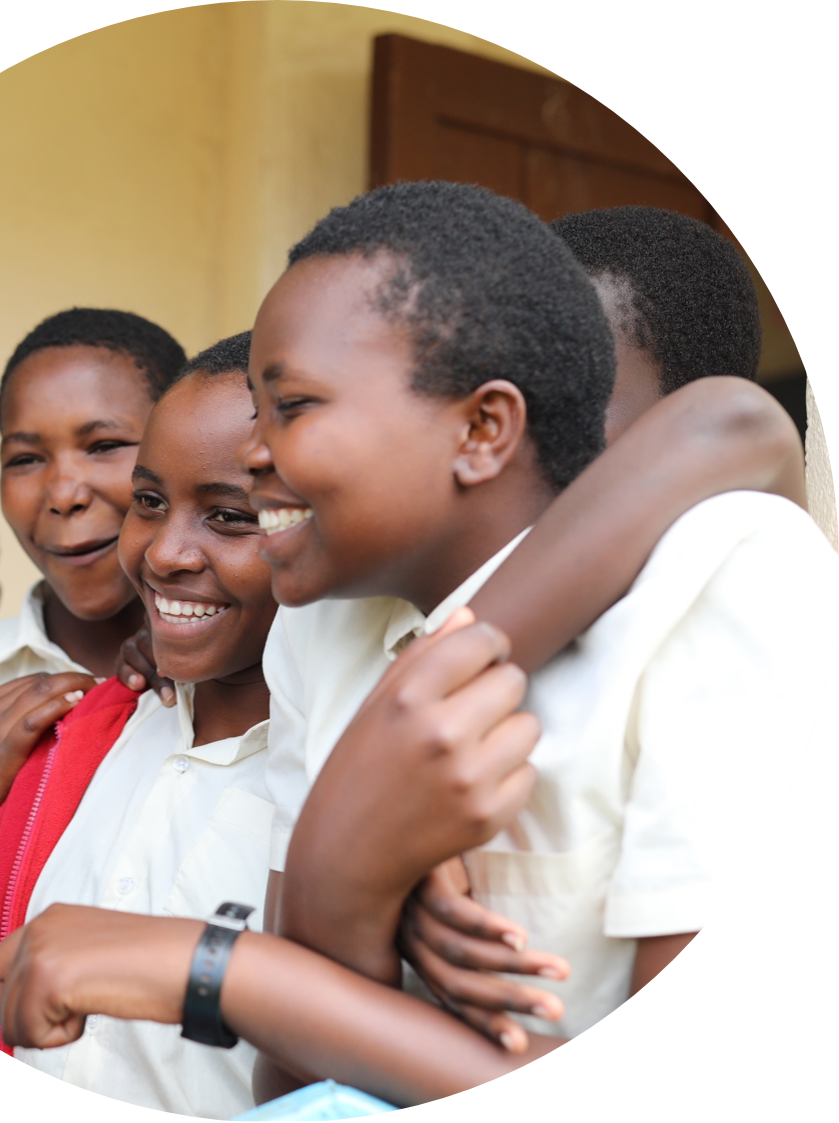 Gender inequality and gender-based violence are a global problem, but especially pronounced in the Global South where women are often seen as property and valued for their bride price. In Kenya, women and adolescent girls are most vulnerable, particularly in rural areas. From insufficient financial resources to harmful cultural norms, the cycle of poverty and discrimination affects generations of women and girls.
Gender inequality and gender-based violence are a global problem, but especially pronounced in the Global South where women are often seen as property and valued for their bride price. In Kenya, women and adolescent girls are most vulnerable, particularly in rural areas. From insufficient financial resources to harmful cultural norms, the cycle of poverty and discrimination affects generations of women and girls.
Kakenya’s Dream operates in southwest rural Kenya, where harmful traditional practices like FGM/C and arranged child marriage are prevalent and generations old. Despite laws banning these practices, 66% of women in the communities have undergone FGM/C and half are married before the age of 19. Only 58% of the girls complete primary school and only 23% finish high school. These realities contribute to pervasive poverty and poor health outcomes.
In order to identify the girls who are most in need of Kakenya’s Dream’s holistic support, the organization prioritizes girls who face these life challenges most acutely – those whose families have never sent a girl to high school, those who are orphans, and those from single parent families with limited resources. Out of a cohort of 35 – 40 girls, 15 students are admitted based on academic merit, with the remainder admitted based on need. Because academic performance is often tied to economic hardship, girls who lack proper nutrition, have to walk long distances to elementary school, or miss school due to household chores are most likely to suffer poor performance.
How the Grant Will be Used
Together Women Rise will fund Empowering Marginalized Girls in Rural Kenya, a project to support continued expansion of student education and welfare programs and staffing for Kakenya Center for Excellence II (KCE II), a full-support, all-girls boarding school for grades 7 through 12 in a remote Massai village in Narok County, Kenya. This is a critical age for girls, as they face intense pressure to drop out, undergo FGM/C, and marry young. The school provides the opportunity to nurture and release the potential of young women and creates a space for gender equality in a community that has a long history of female suppression.
Built on land donated by the village elders, KCE campuses are beacons of hope in the community. The first classroom building on the KCE I campus opened in 2009. From 2010-2017, that first campus expanded to meet the needs of its growing student population, offering art and science facilities, safe dormitories, teacher housing, a multi-purpose hall, and a library. In 2017, Kakenya’s Dream broke ground on its second campus, KCE II. Indigenous trees and vegetable gardens bring life to the grounds, while still leaving plenty of room for students to play sports and learn outdoors.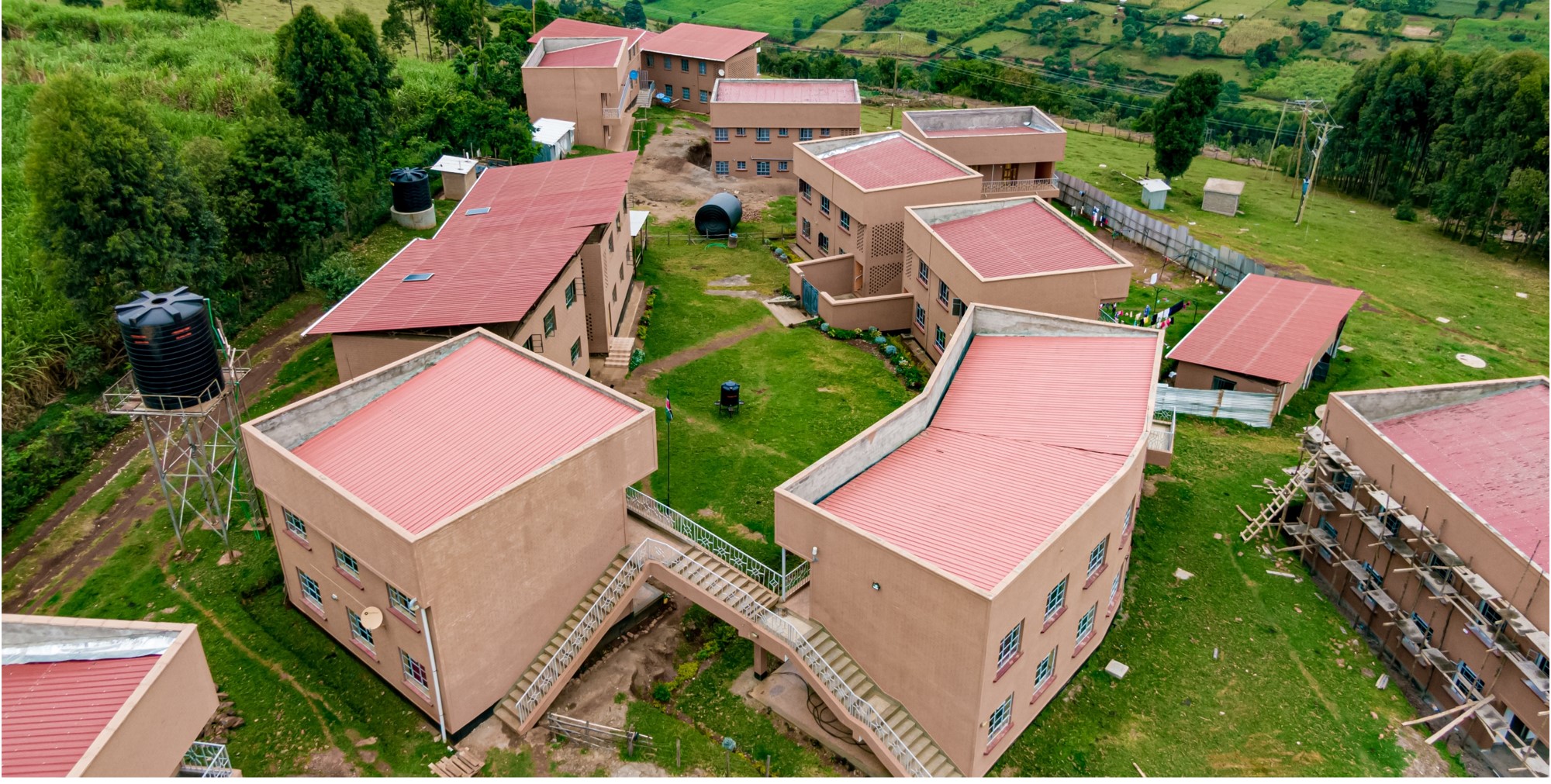
KCE II holistically addresses obstacles from harmful traditional practices, negative social norms, physical and mental health concerns, past trauma, nutrition, socioeconomic limitations, and more.
The primary goals of KCE II are to:
- Improve students’ retention and educational achievement through high school
- Remove the social and cultural barriers to girls’ education
- Empower students to become agents of change in addressing child rights violations (FGM/C, child marriage)
- Empower and motivate students to achieve their first-choice destination after high school.
These goals are achieved through differentiating elements to ensure that 100% of the students graduate from high school, free from FGM and child marriage.
- Girls participate in extended learning activities in arts, sports, and STEM (science, technology, engineering, and mathematics) so they can explore diverse career paths and gain leadership skills.
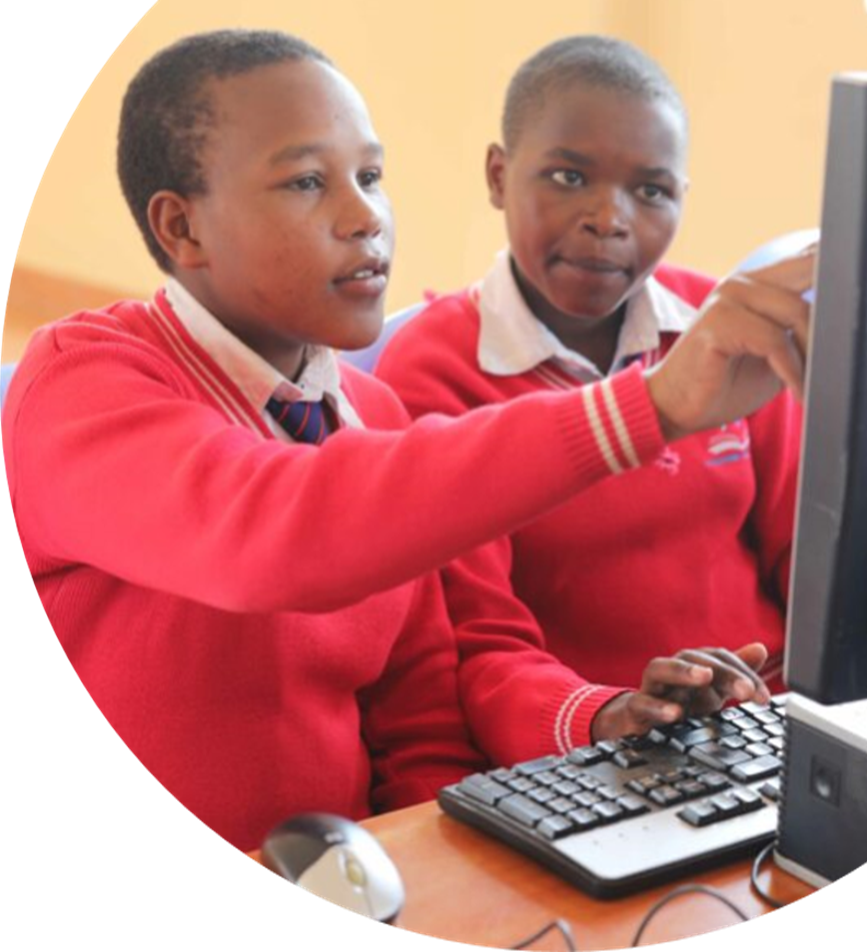 Students are fed nutritious meals from campus gardens and receive medical and mental health check-ups, a rarity in rural schools.
Students are fed nutritious meals from campus gardens and receive medical and mental health check-ups, a rarity in rural schools.- They are taught comprehensive sexual and reproductive health education, which outside of Kakenya’s Dream’s programs, does not occur in the region.
- Students are paired with peer mentors who are trained and recruited from KCE alumnae to help girls envision their own potential and encourage them to make healthy life decisions, including staying in school and delaying marriage. This peer-led approach empowers alumnae to be positive role models. Coming from the same community, mentors are able to identify with the challenges younger girls experience.
- 100% of alumnae have transitioned to tertiary education, receiving financial, academic, and social support alongside practical career skills development for their next life phase.
IMPACT – Direct: 268 women and girls; Indirect: 1,609 women and girls
Budget
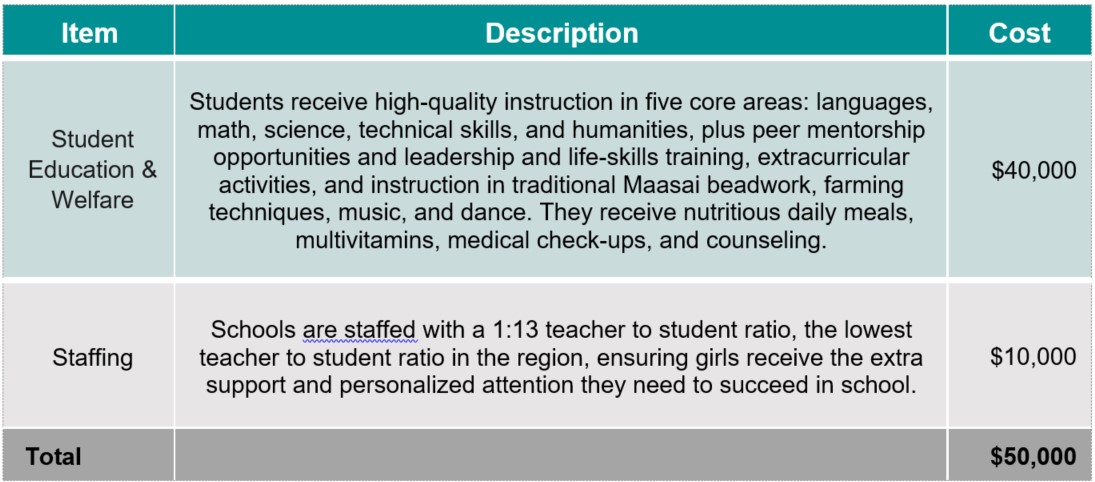
Why We Love This Project/Organization
Kakenya’s Dream, is an experienced organization with a strong local program and impressive results, as witnessed in the previous grants that Together Women Rise funded in 2014 and 2019. We love that the organization is run by a Maasai woman and that it offers a comprehensive program that empowers and educates at-risk girls.
Impact Story
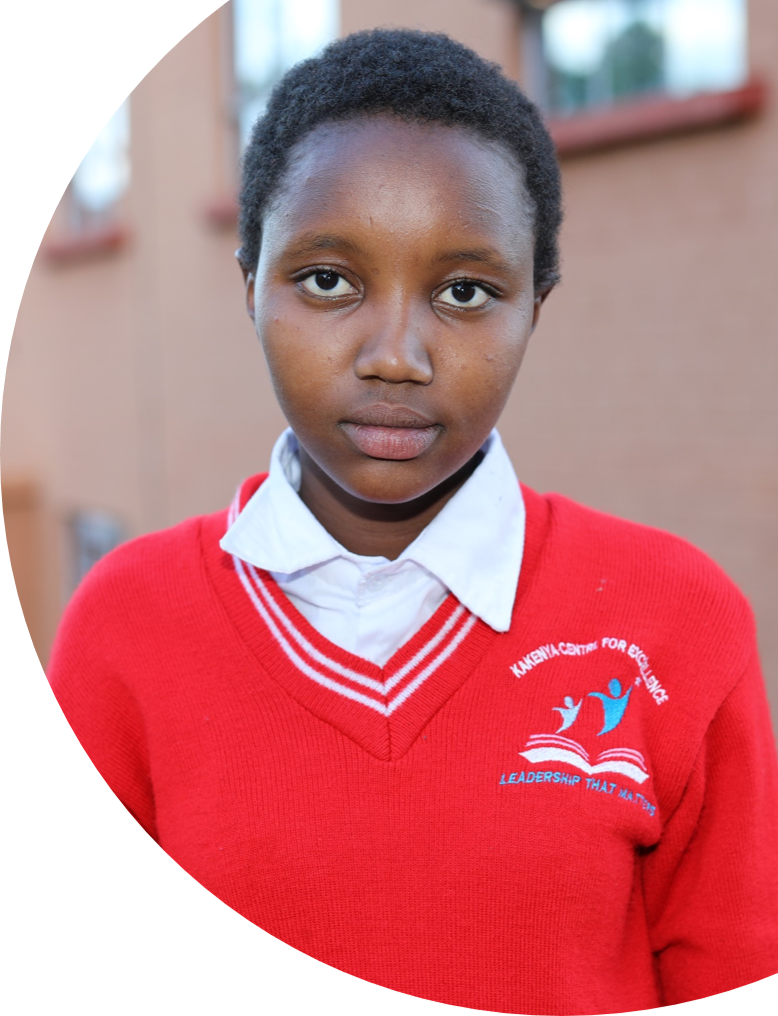 Meet Magdalene
Meet Magdalene
Magdalene, 15, is the eldest of six children. Her parents, like many others in rural Kenya, are pastoralists, which means their livelihoods revolve around raising and herding livestock. Since these herds require water and grazing pastures to survive, pastoralists depend heavily on the local environment, which makes them especially vulnerable to climate disruptions and natural disasters. The country’s recent drought, the worst in four decades, was devastating for Magdalene’s family and to an estimated 20 million people who face acute food insecurity as a direct result.
When the drought began in late 2020, every well and borehole around Magdalene’s village dried up. To fetch clean water (a responsibility that falls disproportionately on girls), she was forced to walk five hours to the nearest river. In such dire conditions, her family struggled to meet their own needs, let alone the needs of their livestock.
With his livelihood slashed, Magdalene’s father could no longer afford to send her to high school, and she was forced to turn down an admissions offer. Without an education, her options would be bleak. “I was afraid I may be forced to stay at home longer and be pushed by circumstances into child marriage,” she said.
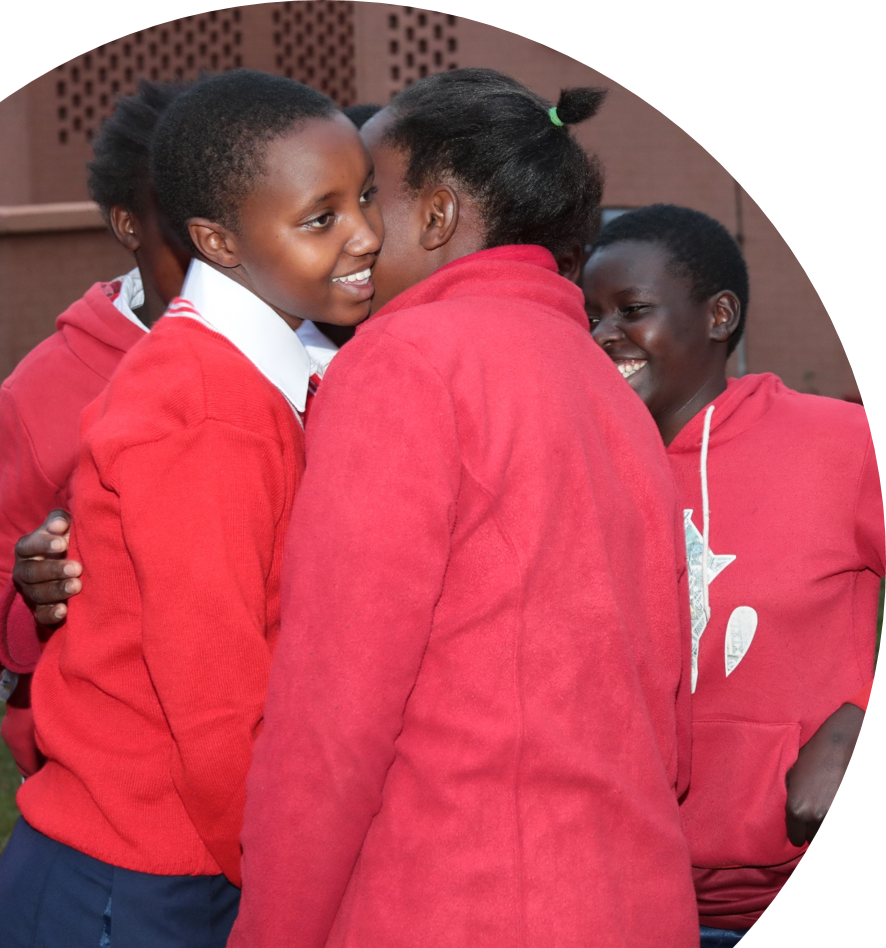 This is a common fate in the communities that Kakenya’s Dream serves, where 50% of girls are married before the age of 19. In times of crisis, this rate rises even higher. Across sub-Saharan Africa, marriages traditionally include a bride price, which can turn young girls into financial assets for desperate families with no other means of generating income. But before her fate was sealed, a radio station in Nairobi invited Magdalene and several other girls from the country’s drought-stricken regions to tell their stories on air. Her story inspired listeners across the country, including the staff at Kakenya’s Dream, which offered to sponsor her education. She and her parents soon made the 12-hour journey from their home to the KCE II campus. Magdalene arrived about a month into the 13-week academic term.
This is a common fate in the communities that Kakenya’s Dream serves, where 50% of girls are married before the age of 19. In times of crisis, this rate rises even higher. Across sub-Saharan Africa, marriages traditionally include a bride price, which can turn young girls into financial assets for desperate families with no other means of generating income. But before her fate was sealed, a radio station in Nairobi invited Magdalene and several other girls from the country’s drought-stricken regions to tell their stories on air. Her story inspired listeners across the country, including the staff at Kakenya’s Dream, which offered to sponsor her education. She and her parents soon made the 12-hour journey from their home to the KCE II campus. Magdalene arrived about a month into the 13-week academic term.
“I managed to catch up because my classmates and teachers helped me with the study materials I needed,” she said.
Despite her delayed enrollment, Magdalene performed exceptionally well on her end-of-term exams . Magdalene now has her sights set on attending university, where she plans to pursue her passion for performing arts and land her dream career in medicine.
| “I was ready to join any school, even if learning would be under a tree… I was impressed by the magnificent buildings. I was happy. I was given everything, including uniforms, boarding materials, and personal effects.”
– Magdalene |
Learn More
Source Materials
UN Office of the High Commissioner
Glossary
FGM/C:
KCE: Kakenya’s Center for Excellence
Bride price: payment made by the groom to the family of the bride
SRH: Sexual and reproductive health
STEM: science, technology, engineering, and mathematics
The Global South: The Global South includes the countries that experience higher levels of poverty, income inequality, lower life expectancy, and harsh living conditions compared to the wealthier nations in the “Global North” – located mostly in North America and Europe. The Global South primarily includes many of the countries in Africa, Latin America, the Caribbean, Asia and the Pacific, and the Middle East.
